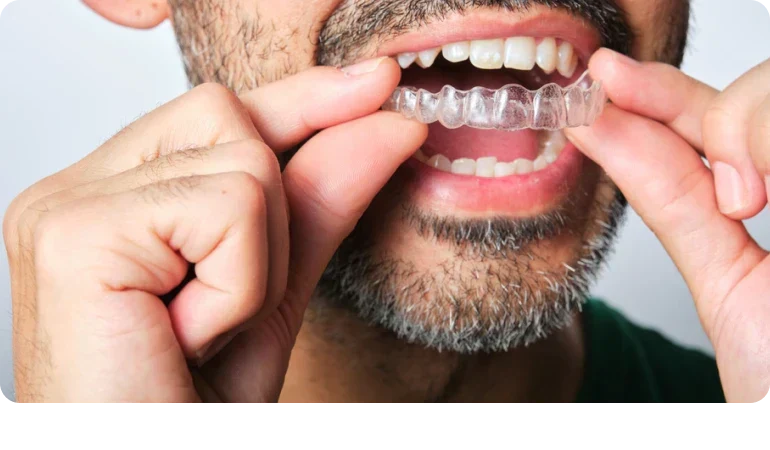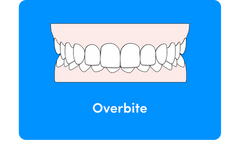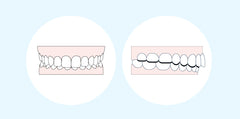Table of Content
An overbite might seem like just a cosmetic concern, but in reality, it can impact everything from your bite function to jaw comfort and even long-term oral health. If you're exploring ways to correct an overbite, you may have wondered: "Can retainers fix an overbite, or is more advanced treatment required?" Let's dive into what retainers can do for an overbite, when they're recommended, and whether they're the right solution for your smile.
What is an overbite?
An overbite occurs when your upper front teeth excessively overlap the lower front teeth. A slight overbite is completely normal, but a more pronounced one—often called a “deep bite”—can cause issues such as:
-
Jaw pain or TMJ dysfunction
-
Worn or chipped teeth
-
Difficulty chewing
-
Speech problems
-
Aesthetic concerns
What does a retainer do?
A retainer is a custom-made appliance designed to hold teeth in position after wearing braces or clear aligners. After a teeth straightening treatment, there is still a chance of orthodontic relapse. You wouldn't want your hard-earned smile to go to waste. It is essential to use retainers as the post-care treatment to keep your smile forever. There are two main types:
Removable retainers
Hawley retainers and clear retainers are among the types of removable retainers. Hawley retainers include a metallic wire attached to an acrylic base. On the other hand, clear retainers are made up of transparent plastic material, more like clear aligners.
Fixed retainers
This type of retainer is bonded to the back of the teeth to ensure that your teeth stay in their new position. Retainers are primarily used to maintain results after your bite has already been corrected, not to initiate significant movement in your teeth or jaw.
Fixing an overbite with a retainer
A retainer is an orthodontic device designed to maintain the alignment of your teeth after treatment. When it comes to correcting malocclusions like an overbite, active treatment options, such as braces or clear aligners, are typically required. The most suitable approach depends on the severity of your case, and your dentist or orthodontist can recommend the best course of action based on your specific needs.
Orthodontic solutions for overbite
If your overbite is more pronounced or due to jaw structure issues, your dentist or orthodontist may recommend:
Traditional braces
Metal braces are the oldest known method for treating dental malocclusion, including an overbite.
Clear aligners

They are a perfect alternative to traditional braces. For anyone looking for a more discreet and comfortable smile transformation. They tend to exert a mild to moderate pressure on the teeth and gradually move both teeth and bite into better alignment.
Is your misaligned smile holding you back?
With Caspersmile clear aligners, get the smile of your dreams.
Shop now
Elastics (rubber bands)
Jaw surgery
For adults with severe skeletal overbites that can't be corrected with orthodontics alone Once the main treatment is completed, a retainer will be crucial to prevent your overbite from relapsing.
Why you shouldn't ignore an overbite
While you might not mind the way your smile looks, leaving an overbite untreated can lead to complications:
Tooth wear
Misaligned teeth can grind against each other, weakening enamel.
Jaw pain or TMJ issues
An imbalanced bite strains your joints and muscles.
Gum recession or damage
Overlapping teeth may press too hard on soft tissue.
Difficulty speaking or eating
A deep bite can affect oral function.
Relapse after previous treatment
If you've had braces and don't wear your retainer, your bite may shift back.
Addressing an overbite early—whether with a retainer or more advanced treatment—helps protect your smile for the long haul.
To learn more about retainers, call us at +44 20 3872 2812.
Should you get a retainer for your overbite?
Retainers for overbite are not the right approach, as they are meant to keep your teeth in their new place. Usually, a retainer after braces for an overbite helps with the maintenance. For cases like an overbite, a retainer won't be enough, but it still plays a key role after treatment is done. You can look forward to any orthodontic treatment to align an overbite.
FAQs

References
American Association of Orthodontists. Multiple pages reviewed. Will I Need to Wear Retainers After Treatment? (https://www.aaoinfo.org/blog/will-i-need-to-wear-retainers/) Accessed 8/25/2022.
Dentaly.org. Teeth Retainers: What's the Best Type? Hawley, Essix, and More (https://www.dentaly.org/us/adult-braces/teeth-retainers/). Accessed 8/25/2022.
Health Direct. Dental braces and retainers (https://www.healthdirect.gov.au/dental-braces-and-retainers). Accessed 8/25/2022.
NHS. Orthodontic treatments (https://www.nhs.uk/conditions/orthodontics/treatments/). Accessed 8/25/2022.
Chite-Quispe L, Sánchez-Tito M. Analysis of the association between facial biotype, overbite and overjet in the permanent dentition (https://pubmed.ncbi.nlm.nih.gov/37214746/). J Clin Exp Dent. 2023 May 1;15(5):e376-e381. Accessed 2/9/2024.
De Ridder L, Aleksieva A, Willems G, Declerck D, Cadenas de Llano-Pérula M. Prevalence of Orthodontic Malocclusions in Healthy Children and Adolescents: A Systematic Review (https://pubmed.ncbi.nlm.nih.gov/35742703/). Int J Environ Res Public Health. 2022 Jun 17;19(12):7446. Accessed 2/9/2024.
Ghodasra R, Brizuela M. Orthodontics, Malocclusion (https://pubmed.ncbi.nlm.nih.gov/37276298/). 2023 Apr 23. In: StatPearls [Internet]. Treasure Island (FL): StatPearls Publishing; 2023 Jan-. Accessed 2/9/2024.
Related Articles
Subscribe our newsletter
By clicking subscribe, you agree to our Privacy Policy and opt in to receive communications from Caspersmile. You can unsubscribe at any time.



